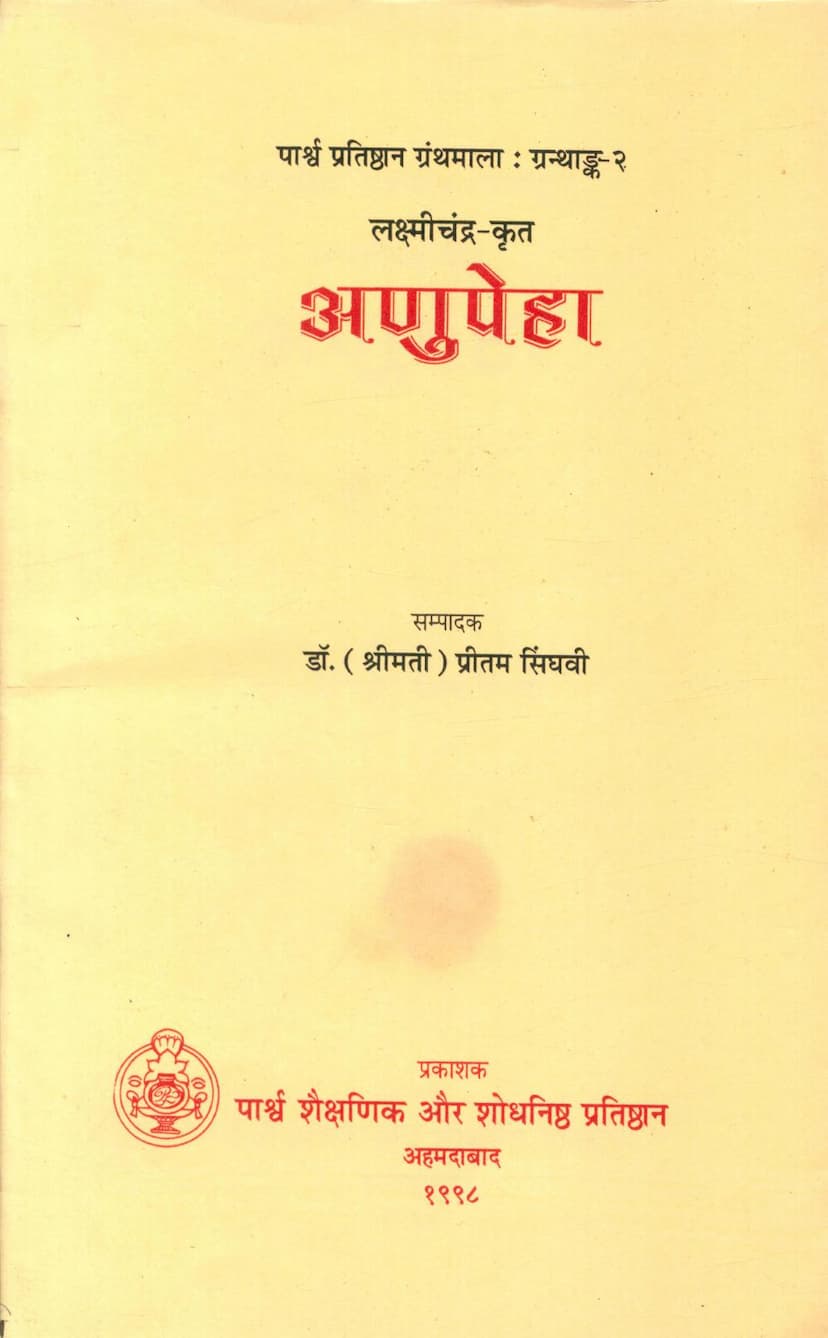Anupeha
Added to library: September 1, 2025

Summary
Here's a comprehensive summary of the Jain text "Anupeha" by Muni Lakshmichandra, as presented in the provided catalog link and excerpts:
Book Title: Anupeha Author: Muni Lakshmichandra Editor: Dr. (Smt.) Pritam Singhvi Publisher: Parshwa International Shaikshanik aur Shodhnishth Pratishthan, Ahmedabad Year of Publication: 1998 Language: Post-Apabhramśa (with Hindi translation)
Overall Purpose and Significance:
"Anupeha," also known as "Doha-velli" or "Dvadasha Anupreksha" (Twelve Reflections), is a significant work in later Jain literature. Written in the Post-Apabhramśa language, it presents twelve fundamental Jain spiritual reflections or contemplations, known as Anupreksas or Bhavnas. The text's primary aim is to guide individuals towards spiritual progress by fostering detachment from worldly concerns, protecting them from negative tendencies, and inspiring their pursuit of final liberation (moksha). These reflections are considered aids to spiritual growth and are intended to purify thoughts and actions.
Author and Manuscript:
The text was authored by Muni Lakshmichandra. The edition presented here is based on the only known manuscript of "Anupeha," which was sourced from the Amer Shastra Bhandar in Jaipur. The editor, Dr. Pritam Singhvi, meticulously compiled and edited the text from a xerox copy of this manuscript.
Content and Structure:
The work comprises 45 dohas (couplets).
- Opening: The first doha serves as an invocation, paying respects to the Siddhas and Maharishees. The second doha highlights the importance of anupreksas.
- The Twelve Anupreksas: The core of the text consists of twelve sections, each dedicated to a specific anupreksha. These are presented in a clear and simple language, making them accessible for contemplation. The specific order of the twelve anupreksas in Lakshmichandra's work, as detailed in the text, is:
- Anitya (Impermanence): Dohas 3-4
- Asharan (Non-protection/Help): Dohas 5-6
- Sansar (Cycle of Birth and Death): Dohas 7-8
- Ekatva (Oneness/Solitude): Dohas 9-10
- Anyatva (Otherness): Dohas 11-12
- Ashuchi (Impurity): Dohas 13-14
- Ashrav (Influx of Karma): Dohas 15-16
- Samvar (Cessation of Karma): Dohas 17-18
- Nirjara (Shedding of Karma): Doha 19
- Lok Swabhav (Nature of the Universe): Doha 20
- Bodhi Durlabh (Rarity of Enlightenment): Doha 21
- Dharma (Righteousness/Law): Dohas 22-44
- Conclusion: The 45th doha serves as a concluding remark, urging the reader to practice these anupreksas for spiritual gain.
The sequence of these twelve anupreksas closely follows the traditional order found in Jain scriptures like the Tattvartha Sutra.
Theological and Philosophical Context:
The text draws upon a long-standing Jain tradition of anupreksha or bhavna literature, which has roots in the earliest Jain Agamas like the Acharanga Sutra and is extensively discussed in the Uttaradhyayana Sutra. Both Digambara and Shvetambara traditions have produced numerous works on this theme in various languages. The influence of Buddhist Vajrayana and Sahajayana Siddhas in Apabhramśa literature is also acknowledged as a contributing factor to the development of such doha-based spiritual compositions in Jainism. Key examples mentioned include Kundakunda's works and Kartikeyānupreksha.
Linguistic and Stylistic Aspects:
- Language: The language is Post-Apabhramśa, characterized by a blend of older and evolving linguistic features. The editor notes some modernizations and has made corrections for inaccuracies in the manuscript.
- Style: The style is characterized by its simplicity and directness, intended to effectively convey the spiritual message to a broad audience.
- Meter: The text is composed in the doha meter, a popular form for spiritual and didactic literature during that period, influenced by similar compositions in Buddhist traditions.
Dating the Work:
Based on the lineage of Muni Sumatikirti (which includes Lakshmichandra as a predecessor), and assuming a generational gap of 20-25 years, the time of Lakshmichandra is estimated to be around the mid-15th century CE. This would place Muni Mahachandra (author of Barahakkhara-kakka) in the 16th century CE.
Editorial Contribution:
Dr. Pritam Singhvi's scholarly contribution is highly valued. She has provided a critical edition of the text, along with a Hindi translation and valuable annotations. The editor expresses gratitude to institutions and individuals who facilitated this publication, particularly the Apabhramśa Sahitya Academy (Jain Vidya Sansthan, Digambar Jain Atishay Shri Mahavirji, Jaipur) and Dr. Kamalchand Sogani for providing the manuscript copy. She also acknowledges the significant guidance received from Dr. H. V. Bhayani in understanding and editing the original text.
In essence, "Anupeha" by Muni Lakshmichandra, as presented and edited by Dr. Pritam Singhvi, offers a profound and accessible exploration of twelve core Jain spiritual contemplations, designed to lead the practitioner towards self-realization and liberation.